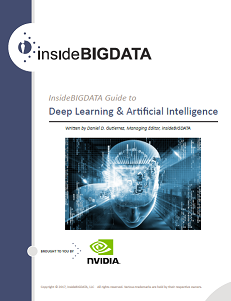The insideBIGDATA Guide to Deep Learning & Artificial Intelligence is a useful new resource directed toward enterprise thought leaders who wish to gain strategic insights into this exciting area of technology. In this guide, we take a high-level view of AI and deep learning in terms of how it’s being used and what technological advances have made it possible. We also explain the difference between AI, machine learning and deep learning, and examine the intersection of AI and HPC. We present the results of a recent insideBIGDATA survey that reflects how well these new technologies are being received. Finally, we take a look at a number of high-profile use case examples showing the effective use of AI in a variety of problem domains. The complete insideBIGDATA Guide to Deep Learning & Artificial Intelligence is available for download from the insideBIGDATA White Paper Library.
 Accelerating Analytics for the Enterprise
Accelerating Analytics for the Enterprise
The field of AI has seen a significant increase in interest in the past couple of years, including an upswing in the number of large enterprises running their own experiments with AI systems. The vast majority of AI projects in enterprises is still at the experimentation stage where about half of large enterprises are experimenting with “smart computing” projects. These organizations are examining problems and deciding whether AI can be applied to find solutions. These efforts are still in the early stages. But one area that appears to be taking off is how enterprises are now seriously looking at “accelerated analytics” and “AI driven analytics” as a solution to the data deluge many companies are seeing.
“Accelerated Analytics” involve GPU-accelerated solutions, like Kinetica, MapD, SQream Technologies, BlazingDB, Graphistry, and BlazeGraph. These solutions allow you to access and interact with data in milliseconds. It’s no longer just about Hadoop and Spark with analysts having to wait a minute and then go on to the next query.
Solutions from Graphistry, a visual graph company, offer the ability to look at security logs. You can point Graphistry at a Splunk implementation and quickly go through hundreds of thousands of security alerts for the day. Instead of just doing a report, you can actually visualize trouble spots and keep dissecting and going deeper from a visual standpoint. Many enterprises are using the graph analytic approach to understand the data so you get the correlations with 100x more data.
“AI driven analytics” addresses the needs of the enterprise’s digital business and getting access to information. Accelerating the analytics component is one side of the equation, the other side is doing it at a fraction of the cost, or “stronge scale.”
There’s a need for GPU acceleration since doubling of traditional processors every 18 to 24 months (per Moore’s Law) isn’t happening anymore. GPUs accelerate in-memory databases. For example, Kinetica is 50-100x faster on queries with large data sets than traditional x86 databases. Further, noted blogger, Mark Litwintschik has benchmarked MapD vs. major CPU systems and found it to be between 74x to 3500x faster than CPU DBs.
Accelerating Machine Learning
GPUs have proven their value for machine learning, offering orders-of-magnitude speedups on dense and sparse data. They define the current performance limits for machine learning but have limited model capacity. Academic researchers are working on methods to mitigate that challenge and achieve linear speedups with GPUs on commodity networks. One compelling project is BIDMach from U.C Berkeley, a machine-learning toolkit similar to MLlib for Spark that has demonstrated a two-orders-of-magnitude gain over other systems when run on GPU hardware. BIDMach makes full use of both CPU and GPU acceleration. BIDMach often outperforms cluster systems on problems where models fit in GPU memory and defines the performance limit for small-model problems. Still, Scaling BIDMACH is not an easy task. With two-orders-of-magnitude more computation at each node, a proportionate increase in network bandwidth is needed to avoid stifling performance. Alternately, we need to find radical ways to reduce the load on the network.
Becoming an AI Enterprise
Enterprises also appear to be embracing the idea of businesses accessing, and processing, and taking advantage of data by using AI machine learning or deep learning, in other words—becoming an “AI enterprise.” This is the year we’re going to cross into the zettabyte regime in terms of data volume. So with the amount of data that’s at our disposal, coupled with the intended applications of the data, enterprises are looking for new ways to manage it all. The whole idea of drowning in your “data deluge,” predicates that enterprises look for new solutions. The motivation is to do more with valuable data assets—start using AI, machine learning and deep learning. The whole mindset is changing from being overwhelmed by the data deluge, to actually being data hungry. AI is opening an insatiable desire for data.
The complete insideBIGDATA Guide to Deep Learning & Artificial Intelligence is available for download from the insideBIGDATA White Paper Library, courtesy of NVIDIA.




Speak Your Mind